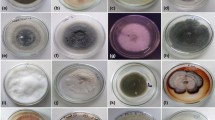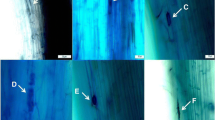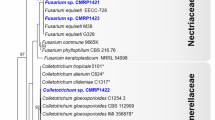Abstract
Endophytic fungi are ubiquitously distributed in orchids and have a great impact on the host plant. The diversity of endophytic fungi in the medicinal orchid Dendrobium loddigesii Rolfe was investigated and their bioactivities in microbe and plant growth were explored here. Endophytic fungi were identified by using morphological and molecular biological methods. Antimicrobial activity was determined by a standard disk assay. Activity in promoting plant growth was confirmed by root inoculation of endophytic fungi in seedling tray and pot experiments. Overall, 48 isolates were isolated from D. loddigesii and identified to belong to 18 genera, with Fusarium and Acremonium being the most dominant populations. A total of 17 isolates belonging to 9 genera were screened for their antimicrobial activity, and Fusarium spp., 8 of the 17 isolates, was also the dominant population. In the seedling tray experiment, two isolates, one of Fusarium named DL26 and the other of Pyrenochaeta named DL351, were shown to enhance plant growth in alder bark–humus medium, and the latter displayed weak activity against Bacillus subtilis (As 1.308) and Aspergillus fumigatus (As 3.2910). In the pot experiment, after inoculation of DL26 and DL351, five out of seven media were fit for plant-endophyte symbionts. Medium #1 of red brick fragments and sphagna was optimal in accelerating plant growth. In conclusion, a great diversity of endophytic fungi in D. loddigesii was first confirmed in a considerable proportion of antimicrobial isolates. Furthermore, two endophytes exhibited the ability to enhance plant growth although their activities were influenced by the growth media.


Similar content being viewed by others
References
Altschul SF, Gish W, Miller W, Myers EW, Lipman DJ (1990) Basic local alignment search tool. J Mol Biol 215:403–410
Arnold AE, Mejia LC, Kyllo D, Rojas E, Maynard Z, Robbins N, Herre EA (2003) Fungal endophytes limit pathogen damage in a tropical tree. Proc Natl Acad Sci USA 100:15649–15654
Arnold AE, Henk DA, Eells RA, Lutzoni F, Vilgalys R (2007) Diversity and phylogenetic affinities of foliar fungal endophytes in loblolly pine inferred by culturing and environmental PCR. Mycologia 99:185–206
Baltruschat H, Fodor J, Harrach BD, Niemczyk E, Barna B, Gullner G, Janeczko A, Kogel KH, Schäfer P, Schwarczinger I, Zuccaro A, Skoczowski A (2008) Salt tolerance of barley induced by the root endophyte Piriformospora indica is associated with a strong increase in antioxidants. New Phytol 180:501–510
Bayman B, Lebron LL, Tremblay RL, Lodge DJ (1997) Variation in endophytic fungi from roots and leaves of Lepanthes (Orchidaceae). New Phytol 135:43–149
Campanile G, Ruscelli A, Luisi N (2007) Antagonistic activity of endophytic fungi towards Diplodia corticola assessed by in vitro and in planta tests. Eur J Plant Pathol 117:237–246
Chang DCN (2007) The screening of orchid mycorrhizal fungi (OMF) and their applications. In: Chen WH, Chen HH (eds) Orchid biotechnology. World Scientific Publishing, Singapore, pp 77–98
Chen SY, Chen FJ (2003) Fungal parasitism of Heterodera glycines eggs as influenced by egg age and pre-colonization of cysts by other fungi. J Nematol 35:271–277
Chen XM, Guo SX (2005) Effect of four species of endophytic fungi on the growth and polysaccharide and alkaloid contents of Dendrobium nobile. Zhongguo Zhongyao Zazhi 30:253–257 (in Chinese)
Desnos-Ollivier M, Bretaqne S, Dromer F, Lortholary O, Dannaoui E (2006) Molecular identification of black-grain mycetoma agents. J Clin Microbiol 44:3517–3523
Doyle JJ, Doyle JL (1987) A rapid DNA isolation procedure for small quantities of fresh leaf tissues. Phytochem Bull 19:11–15
Faeth SH, Fagan WF (2002) Fungal endophytes: common host plant symbionts but uncommon mutualists. Integr Comp Biol 42:360–368
Fiume G, Fiume F (2008) Biological control of corky root in tomato. Commun Agric Appl Biol Sci 73:233–248
Gong LJ, Guo SX (2009) Endophytic fungi from Dracaena cambodiana and Aquilaria sinensis and their antimicrobial activity. Afr J Biotechnol 8:731–736
Guo LD, Hyde KD, Liew ECY (2000) Identification of endophytic fungi from Livistona chinensis based on morphology and rDNA sequences. New Phytol 147:617–630
Herre EA, Mejia LC, Kyllo DA, Rojas E, Maynard Z, Butler A, Van Bael SA (2007) Ecological implications of anti-pathogen effects of tropical fungal endophytes and mycorrhizae. Ecology 88:550–558
Khan SA, Hamayun M, Yoon H, Kim HY, Suh SJ, Hwang SK, Kim JM, Lee IJ, Choo YS, Yoon UH, Kong WS, Lee BM, Kim JG (2008) Plant growth promotion and Penicillium citrinum. BMC Microbiol 8:231
Li TX, Wang JK, Lu ZH (2005) Accurate identification of closely related Dendrobium species with multiple species-specific gDNA probes. J Biochem Biophys Methods 62:111–123
Li WC, Zhou J, Guo SY, Guo LD (2007) Endophytic fungi associated with lichens in Baihua mountain of Beijing, China. Fungal Divers 25:69–80
Michielse CB, Rep M (2009) Pathogen profile update: Fusarium oxysporum. Mol Plant Pathol 10:311–324
Perk JH, Choi GJ, Lee SW, Jang KS, Choi YH, Cho KY, Kim JC (2003) Screening for antifungal endophytic fungi against six plant pathogenic fungi. Mycobiology 31:179–182
Petrini O (1991) Fungal endophytes of leaves. In: Andrews JH, Hirano SS (eds) Microbial ecology of leaves. Springer-Verlag, Berlin, pp 179–197
Phongpaichit S, Rungjindamai N, Rukachaisirikul V, Sakayaroj J (2006) Antimicrobial activity in cultures of endophytic fungi isolated from Garcinia species. FEMS Immunol Med Microbiol 48:367–372
Qian L, Ding G, Zhou Q, Feng ZY, Ding XY, Gu S, Wang Y, Li XX, Chu BH (2008) Molecular authentication of Dendrobium loddigesii Rolfe by amplification refractory mutation system (ARMS). Planta Med 74:470–473
Rodriguez RJ, White JF, Arnold AE, Redman RS (2009) Fungal endophytes: diversity and functional roles. New Phytol 182:314–330
Sanchez Marquez S, Bills G, Zabalgogeazcoa I (2007) The endophytic mycobiota of the grass Dactylis glomerata. Fungal Divers 27:171–195
Sparace SA, Reeleder RD, Khanizadeh S (1987) Antibiotic activity of the pyrenocines. Can J Microbiol 33:327–330
Stone JK, Polishook JD, White JF (2004) Endophytic fungi. In: Mueller GM, Bills GF, Foster MS (eds) Biodiversity of fungi, inventory and monitoring methods. Elsevier, Amsterdam, pp 241–270
Tanaka A, Christensen MJ, Takemoto D, Park P, Scott B (2006) Reactive oxygen species play a role in regulating a fungus-perennial ryegrass mutualistic interaction. Plant Cell 18:1052–1066
Tefera T, Vidal S (2009) Effect of inoculation method and plant growth medium on endophytic colonization of sorghum by the entomopathogenic fungus Beauveria bassiana. Biocontrol 54:663–669
Tejesvi MV, Kini KR, Prakash HS, Subbiah V, Shetty HS (2007) Genetic diversity and antifungal activity of species of Pestalotiopsis isolated as endophytes from medicinal plants. Fungal Divers 24:37–54
Tudzynski B, Sharon A (2002) Biosynthesis, biological role and application of fungal phyto-hormones. In: Osiewacz HD (ed) The mycota X, industrial applications. Springer-Verlag, Berlin, pp 183–212
Vicente MF, Cabello A, Platas G, Basilio A, Diez MT, Dreikorn S, Giacobbe RA, Onishi JC, Meinz M, Kurtz MB, Rosenbach M, Thompson J, Abruzzo G, Flattery A, Kong L, Tsipouras A, Wilson KE, Pelaez F (2001) Antimicrobial activity of ergokonin A from Trichoderma longibrachiatum. J Appl Microbiol 91:806–813
Vu T, Hauschild R, Sikora RA (2006) Fusarium oxysporum endophytes induced systemic resistance against Radopholus similis on banana. Nematology 8:847–852
Wang D, Jia SH, Zhang ZX et al (2007) Isolation and culture of an endophytic fungus associated with Dendrobium huoshanense and its effects on the growth of plantlets. J Fungal Res 5:84–88 (in Chinese)
White TJ, Bruns T, Lee S, Taylor J (1990) Amplification and direct sequencing of fungal ribosomal RNA genes for phylogenetics. In: Innis MA, Gelfand DH, Sninsky JJ, White TJ (eds) PCR protocols: a guide to methods and applications. Academic Press, San Diego, pp 315–322
Yuan ZL, Chen YC, Yang Y (2009) Diverse non-mycorrhizal fungal endophytes inhabiting an epiphytic, medicinal orchid (Dendrobium nobile): estimation and characterization. World J Microbiol Biotechnol 25:295–303
Yuan ZL, Zhang CL, Lin FC (2010) Role of diverse non-systemic fungal endophytes in plant performance and response to stress: progress and approaches. J Plant Growth Regul 29:319–343. doi:10.1007/s00344-009-9112-9
Acknowledgment
This study was supported by the Projects in the National Science & Technology Pillar Program in the Eleventh Five-year Plan Period of China (No. 2006BAI06A11-11), National Natural Science Foundation of China (No. 30770068), and the National High Technology Research and Development Program of China (863 Program, No. 2008AA09Z405).
Author information
Authors and Affiliations
Corresponding author
Rights and permissions
About this article
Cite this article
Chen, X.M., Dong, H.L., Hu, K.X. et al. Diversity and Antimicrobial and Plant-Growth-Promoting Activities of Endophytic Fungi in Dendrobium loddigesii Rolfe. J Plant Growth Regul 29, 328–337 (2010). https://doi.org/10.1007/s00344-010-9139-y
Received:
Accepted:
Published:
Issue Date:
DOI: https://doi.org/10.1007/s00344-010-9139-y




